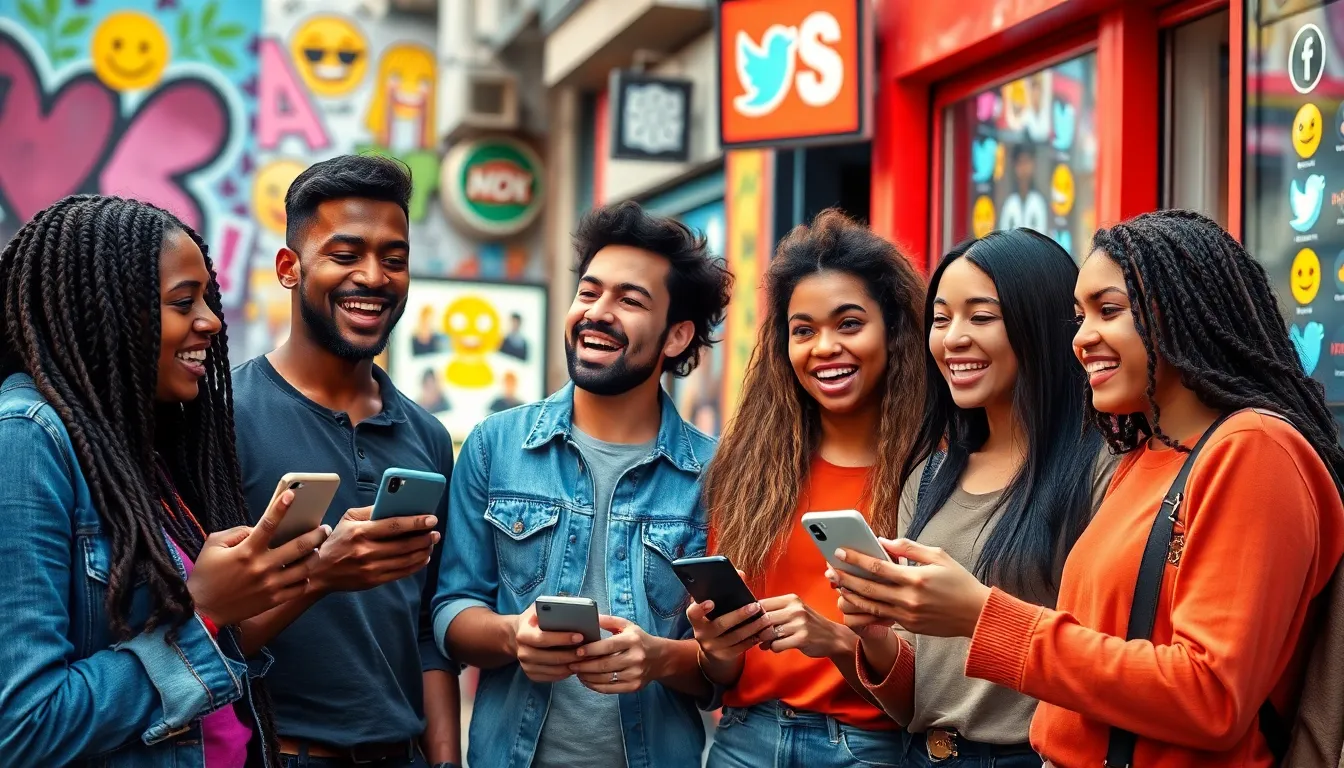As 2024 approaches, it’s time to dust off those linguistic crystal balls and peek into the future of language. From the rise of slang that makes parents cringe to the clever twists of AI-generated content, the way people communicate is evolving faster than ever. If you thought emojis were just a passing phase, think again—this year, they’re gearing up for a comeback that even Shakespeare would envy.
Get ready to dive into the quirky world of language trends that’ll shape conversations, online interactions, and even your favorite memes. Whether you’re a word nerd or just someone who likes to sound smart at parties, understanding these trends will keep you in the loop. So grab a cup of coffee, sit back, and let’s explore what 2024 has in store for the fascinating realm of language.
Table of Contents
ToggleOverview of Language Trends 2024
Language trends in 2024 exhibit rapid changes influenced by technology and cultural shifts. The resurgence of emojis continues to play a vital role in everyday communication. Integrating visual elements enhances expressiveness, shaping how people convey emotions and ideas.
Social media platforms drive the evolution of language as they popularize new phrases and abbreviations. The accessibility of platforms promotes a shift toward informal and spontaneous communication styles. Shortened forms of phrases are likely to dominate, making interactions quicker and more engaging.
AI-generated content significantly impacts language, introducing new vocabulary and grammar structures. Content created by AI often mirrors conversational patterns, influencing user-generated text. As AI technology evolves, language adapts, blending human and machine-created expressions.
The adoption of cultural vernacular is on the rise. Diverse communities contribute unique expressions to the broader language landscape. Communities are not only preserving their linguistic heritage but also enriching global conversations.
Lastly, the phenomenon of language blending is expected to grow. Mixing languages within the same conversation becomes increasingly common, reflecting the multicultural influences of modern society. As linguistic boundaries blur, conversations become more inclusive and dynamic.
These trends offer an intriguing glimpse into how language continues to adapt in a fast-paced, interconnected world. Staying updated on these developments benefits anyone engaged in communication, from casual speakers to language professionals.
Emerging Technologies Impacting Language

Technological advancements increasingly shape language use as 2024 approaches. Innovations in artificial intelligence and voice recognition particularly influence communication dynamics.
Artificial Intelligence in Language Processing
Artificial intelligence plays a critical role in language processing. It generates content that often mirrors human writing styles and introduces new vocabulary. Natural language understanding algorithms enhance translation accuracy across various languages. Data from user interactions inform AI models, refining responses and engaging discussions. Applications like chatbots engage users in meaningful conversations, reflecting the blending of AI-generated and human expression. Collectively, these advancements streamline communication while reshaping conventional language norms.
Voice Recognition Advancements
Voice recognition technology continues to evolve rapidly. Enhanced algorithms improve speech-to-text performance, resulting in more accurate interpretations of spoken language. Applications integrate these advancements for seamless user experiences across devices. Smart assistants like Siri and Google Assistant utilize voice recognition to respond contextually and accurately. Accessibility features also benefit from improved recognition capabilities, allowing diverse populations to communicate effortlessly. These developments foster inclusivity and encourage the adoption of voice-driven communication styles.
Globalization and Language Evolution
As 2024 approaches, globalization significantly shapes language evolution. Communication has transformed, driven by technology and cultural interchange.
Influence of Social Media
Social media platforms play a vital role in language trends. Platforms like Twitter and TikTok popularize new slang and expressions, often appearing instantly. User-created content encourages spontaneity and creativity, allowing phrases to flourish. This environment fosters rapid language change, often reflecting cultural movements and societal issues. Engagement through memes amplifies the influence of language, connecting individuals across diverse backgrounds. A vast array of linguistic styles emerges, illustrating how social media democratizes language, allowing users to shape it collaboratively.
Multilingualism in Online Communication
Online communication encourages multilingualism in daily interactions. Users now blend languages seamlessly, showcasing cultural identities and personal experiences. This phenomenon illustrates the globalization of language and the merging of vernaculars. Digital platforms facilitate language learning by providing immersive environments for practice. Platforms like Duolingo or Babbel encourage users to engage with multiple languages. Access to diverse content, from streaming services to social media, enhances exposure and fluency. Consequently, multilingualism enriches conversations, promoting inclusivity and understanding in global interactions.
Language Learning Trends for 2024
Language learning is evolving rapidly due to technology and innovative methodologies. 2024 brings new approaches that enhance accessibility and engagement in language education.
Innovative Learning Platforms
Innovative platforms are transforming language acquisition experiences. Personalized learning tools harness AI to adapt lessons according to individual student needs. These platforms feature interactive content such as videos, quizzes, and real-time feedback. Mobile apps gain popularity, enabling learners to practice on-the-go. Collaborative tools also facilitate peer interactions, allowing users to learn from each other in social environments. Popular examples include Duolingo, Babbel, and Busuu, which continuously improve their offerings based on user feedback.
Gamification in Language Education
Gamification enhances engagement in language learning processes. By incorporating game elements like points, badges, and leaderboards, educators motivate students to achieve their goals. Users often find themselves more invested in their learning when competition is introduced. Real-life scenarios through role-playing games further immerse students in practical vocabulary and grammar usage. Available platforms such as Quizlet and Kahoot promote this trend by making learning fun and interactive. Gamified approaches hold the potential to significantly improve retention rates and overall language proficiency.
Cultural Influences on Language Trends
Cultural influences increasingly shape language trends as 2024 approaches. Social media platforms profoundly affect communication styles, bringing forth new slang. The popularity of TikTok and Twitter fuels the rapid evolution of language, allowing users to create and share informal expressions. Informality thrives in online environments, enhancing spontaneous interactions and fostering creativity.
AI-generated content continues to redefine language use. It enriches conversations with innovative vocabulary and grammar structures, merging human expression with technology. Chatbots engage users, reflecting this blending while improving language processing accuracy. Consequently, conversational AI enables more nuanced communication, transforming everyday interactions.
Globalization plays a significant role in this dynamic landscape. Cultural interchange leads to a blending of languages, showcasing multicultural influences in digital conversations. This environment encourages a mixture of languages, promoting unique identities and personal narratives. Multilingualism becomes more common as users effortlessly incorporate various linguistic elements.
New learning methodologies drive language education transformation. Personalized learning tools utilizing AI adapt lessons to meet individual needs. Interactive platforms offer mobile apps for learning on-the-go, fostering engagement among users. Gamification strategies enhance motivation, making language acquisition enjoyable. Tools like Quizlet and Kahoot illustrate how creative approaches significantly improve retention and overall language proficiency.
Emojis and memes also contribute to language trends. They enhance expressiveness, offering visual context to written communication. Users exploit these tools to convey emotions and ideas succinctly, enriching conversations in digital spaces. The playful nature of memes encourages collaborative language evolution, reflecting broader cultural movements and societal issues.
These cultural factors invite everyone to participate in the ongoing language transformation. As interconnectedness deepens, staying informed about evolving language trends becomes essential for effective communication.
As 2024 unfolds it’s clear that language will continue to evolve in fascinating ways. The interplay of technology and culture will shape how people communicate and express themselves. From the rise of emojis to the influence of AI-generated content these trends will redefine online interactions and conversations.
Staying attuned to these changes is crucial for anyone looking to enhance their communication skills. Embracing new expressions and adapting to evolving linguistic styles will foster richer connections in an increasingly globalized world. Language enthusiasts and casual speakers alike will find value in understanding the dynamics of this ongoing transformation.

